4.6 The Chemical Senses: Adding Flavour
Somatosensation is all about physical changes in or on the body: Vision and audition sense energetic states of the world—
4.6.1 Smell
Olfaction is the least understood sense and the only one directly connected to the forebrain, with pathways into the frontal lobe, amygdala, and other forebrain structures (recall from the Neuroscience and Behaviour chapter that the other senses connect first to the thalamus). This mapping indicates that smell has a close relationship with areas involved in emotional and social behaviour. Smell seems to have evolved in animals as a signaling sense for the familiar: a friendly creature, an edible food, or a sexually receptive mate.
Countless substances release odours into the air, and some of their odorant molecules make their way into our noses, drifting in on the air we breathe. Situated along the top of the nasal cavity shown in FIGURE 4.28 is a mucous membrane called the olfactory epithelium, which contains about 10 million olfactory receptor neurons (ORNs), receptor cells that initiate the sense of smell. Odorant molecules bind to sites on these specialized receptors, and if enough bindings occur, the ORNs send action potentials into the olfactory nerve (Dalton, 2003).
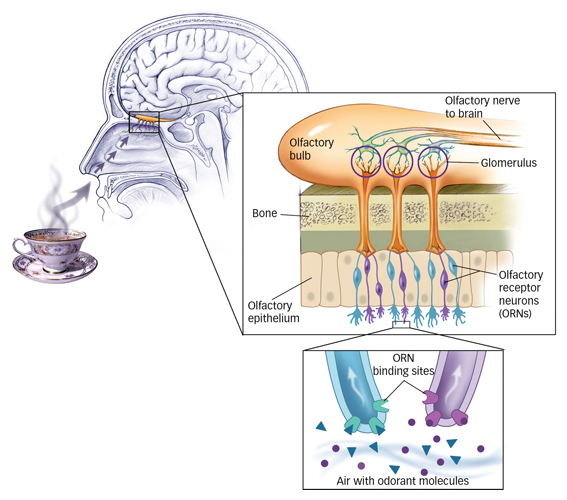
 Figure 4.28: Anatomy of Smell Along the roof of the nasal cavity, odorant molecules dissolve in the mucous membrane that forms the olfactory epithelium. Odorants may then bind to olfactory receptor neurons (ORNs) embedded in the epithelium. ORNs respond to a range of odours and, once activated, relay action potentials to their associated glomeruli in the olfactory bulb, located just beneath the frontal lobes. The glomeruli synapse on neurons whose axons form the olfactory nerve, which projects directly into the forebrain.
Figure 4.28: Anatomy of Smell Along the roof of the nasal cavity, odorant molecules dissolve in the mucous membrane that forms the olfactory epithelium. Odorants may then bind to olfactory receptor neurons (ORNs) embedded in the epithelium. ORNs respond to a range of odours and, once activated, relay action potentials to their associated glomeruli in the olfactory bulb, located just beneath the frontal lobes. The glomeruli synapse on neurons whose axons form the olfactory nerve, which projects directly into the forebrain.
How many scents can humans smell?
Each olfactory neuron has receptors that bind to some odorants but not to others, as if the receptor is a lock and the odorant is the key (see Figure 4.28). Groups of ORNs send their axons from the olfactory epithelium into the olfactory bulb, a brain structure located above the nasal cavity beneath the frontal lobes. Humans possess about 350 different ORN types that permit us to discriminate among some 10 000 different odorants through the unique patterns of neural activity each odorant evokes. This setup is similar to our ability to see a vast range of colours based on only a small number of retinal receptor cell types or to feel a range of skin sensations based on only a handful of touch receptor cell types.
Some dogs have as many as 100 times more ORNs than humans do, producing a correspondingly sharpened ability to detect and discriminate among millions of odours. Nevertheless, humans are sensitive to the smells of some substances in extremely small concentrations. For example, a chemical compound that is added to natural gas to help detect gas leaks can be sensed at a concentration of just 0.0003 part per million. By contrast, acetone (nail polish remover), something most people regard as pungent, can be detected only if its concentration is 15 parts per million or greater.

The olfactory bulb sends outputs to various centres in the brain, including the parts that are responsible for controlling basic drives, emotions, and memories. Odour perception includes both information about the identity of an odour, which involves relating olfactory inputs to information stored in memory (Stevenson & Boakes, 2003), as well as our emotional response to whether it is pleasant or unpleasant (Khan et al., 2007). Which of these processes occurs first? When you walk into a house and encounter the wonderful smell of freshly baked chocolate chip cookies, does your positive emotional response come before you identify the smell or vice versa? According to the object-
The relationship between smell and emotion explains why smells can have immediate, strongly positive or negative effects on us. If the slightest whiff of an apple pie baking brings back fond memories of childhood or the unexpected sniff of vomit mentally returns you to a particularly bad party you once attended, you have the idea. Thankfully, sensory adaptation is at work when it comes to smell, just as it is with the other senses. Whether the associations are good or bad, after just a few minutes the smell fades. Smell adaptation makes sense: It allows us to detect new odours that may require us to act, but after that initial evaluation has occurred, it may be best to reduce our sensitivity to allow us to detect other smells.
Our experience of smell is determined not only by bottom-
HOT SCIENCE: Taste: From the Top Down
In 2008, the publication of a book titled The Wine Trials (Goldstein & Herschkowitsch, 2008) ruffled the feathers of more than a few wine connoisseurs. The book was based on an article in which the authors and several colleagues analyzed the results of 6175 observations gathered during 17 blind wine tastings involving wines of varying prices, organized by lead author and food critic Robin Goldstein (Goldstein et al., 2008). The results suggested that, if anything, tasters liked the more expensive wines slightly less than the more inexpensive ones.
Although these findings will not encourage ordinary wine drinkers to spend a large amount of money on their next wine purchase, they leave open the question of whether knowing a wine’s price affects enjoyment of it. Similar to olfaction, our experience of taste is partly determined by bottom-
To investigate the effects of a top-
Results revealed that during scanning, participants reported liking both wines better when they were accompanied by a high price than by a low price. For the fMRI analysis, the researchers focused on the activity of the medial orbitofrontal cortex (mOFC), a part of the brain located deep inside the frontal lobe that is known to be involved in coding the pleasantness of an experience (Kuhn & Gallinat, 2012). The level of mOFC activity was closely correlated with subjective ratings of taste pleasantness in a previous fMRI study (Kringelbach et al., 2003). As shown in the accompanying figure, there was greater mOFC activity for both wines in the high price condition than in the low price condition.
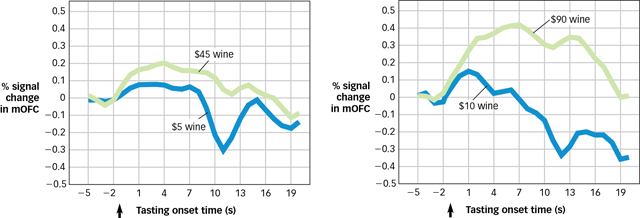
These results demonstrate clearly that taste experience and associated neural activity can be affected by top-
The results of these studies should provide some comfort to wine drinkers who are willing to pay for expensive brands. Even if they cannot tell the difference from cheaper brands under blind tasting conditions, just knowing that they are drinking an expensive wine should make for an enjoyable experience.
Smell may also play a role in social behaviour. Humans and other animals can detect odours from pheromones, biochemical odorants emitted by other members of its species that can affect the animal’s behaviour or physiology. Parents can distinguish the smell of their own children from other people’s children. An infant can identify the smell of its mother’s breast from the smell of other mothers. Pheromones also play a role in reproductive behaviour in insects and in several mammalian species, including mice, dogs, and primates (Brennan & Zufall, 2006). Can the same thing be said of human reproductive behaviour?
Studies of people’s preference for the odours of individuals of the opposite sex have produced mixed results, with no consistent tendency for people to prefer them over other pleasant odours. Recent research, however, has provided a link between sexual orientation and responses to odours that may constitute human pheromones. Researchers used positron emission tomography (PET) scans to study the brain’s response to two odours, one related to testosterone, which is produced in men’s sweat, and the other related to estrogen, which is found in women’s urine. The testosterone-
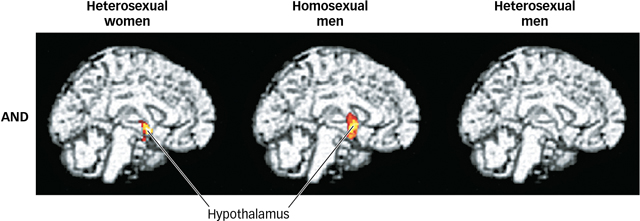
 Figure 4.29: Smell and Social Behaviour In a PET study, heterosexual women, homosexual men, and heterosexual men were scanned as they were presented with each of several odours. During the presentation of a testosterone-
Figure 4.29: Smell and Social Behaviour In a PET study, heterosexual women, homosexual men, and heterosexual men were scanned as they were presented with each of several odours. During the presentation of a testosterone-4.6.2 Taste
Why is the sense of taste an evolutionary advantage?
One of the primary responsibilities of the chemical sense of taste is identifying things that are bad for you—

The tongue is covered with thousands of small bumps, called papillae, which are easily visible to the naked eye. Within each papilla are hundreds of taste buds, the organ of taste transduction (see FIGURE 4.30). The mouth contains 5000 to 10 000 taste buds fairly evenly distributed over the tongue, roof of the mouth, and upper throat (Bartoshuk & Beauchamp, 1994; Halpern, 2002). Each taste bud contains 50 to 100 taste receptor cells. Taste perception fades with age (Methven et al., 2012): On average, people lose half their taste receptors by the time they turn 20. This may help to explain why young children seem to be “fussy eaters,” since their greater number of taste buds brings with it a greater range of taste sensations.
The human eye contains millions of rods and cones, the human nose contains some 350 different types of olfactory receptors, but the taste system contains just five main types of taste receptors, corresponding to five primary taste sensations: salt, sour, bitter, sweet, and umami (savoury). The first four are quite familiar, but umami may not be. In fact, perception researchers are still debating its existence. The umami receptor was discovered by Japanese scientists who attributed it to the tastes evoked by foods containing a high concentration of protein, such as meats and cheeses (Yamaguchi, 1998). If you are a meat eater and you savour the feel of a steak topped with butter or a cheeseburger as it sits in your mouth, you have an idea of the umami sensation.
Each taste bud contains several types of taste receptor cells whose tips, called microvilli, react with tastant molecules in food. Salt taste receptors are most strongly activated by sodium chloride (table salt). Sour receptor cells respond to acids, such as vinegar or lime juice. Bitter and sweet taste receptors are more complex. Some 50 to 80 distinct binding sites in bitter receptors are activated by an equal number of different bitter-
Although umami receptor cells are the least well understood, researchers are homing in on their key features (Chandrashekar et al., 2006). They respond most strongly to glutamate, an amino acid in many protein-
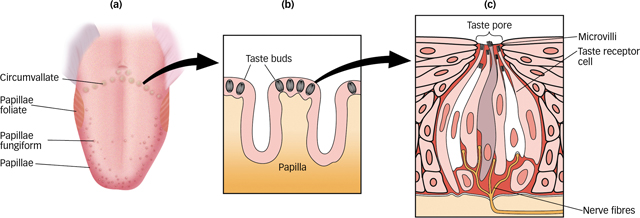
 Figure 4.30: A Taste Bud Taste buds stud the bumps (papillae) on the tongue, shown here, as well as the back, sides, and roof of the mouth (a). Each taste bud contains a range of receptor cells that respond to varying chemical components of foods called tastants (b). Tastant molecules dissolve in saliva and stimulate the microvilli that form the tips of the taste receptor cells (c). Each taste bud contacts the branch of a cranial nerve at its base.
Figure 4.30: A Taste Bud Taste buds stud the bumps (papillae) on the tongue, shown here, as well as the back, sides, and roof of the mouth (a). Each taste bud contains a range of receptor cells that respond to varying chemical components of foods called tastants (b). Tastant molecules dissolve in saliva and stimulate the microvilli that form the tips of the taste receptor cells (c). Each taste bud contacts the branch of a cranial nerve at its base.
Of course, the variety of taste experiences greatly exceeds the five basic receptors discussed here. Any food molecules dissolved in saliva evoke specific, combined patterns of activity in the five taste receptor types. Although we often think of taste as the primary source for flavour, in fact, taste and smell collaborate to produce this complex perception. As any wine connoisseur will attest, the full experience of a wine’s flavour cannot be appreciated without a finely trained sense of smell. Odorants from substances outside your mouth enter the nasal cavity via the nostrils, and odorants in the mouth enter through the back of the throat. This is why wine aficionados are taught to pull air in over wine held in the mouth: It allows the wine’s odorant molecules to enter the nasal cavity through this “back door.” (The taste of wine can also be influenced by cognitive factors, as illustrated in the Hot Science box.)
You can easily demonstrate the contribution of smell to flavour by tasting a few different foods while holding your nose, preventing the olfactory system from detecting their odours. If you have a head cold, you probably already know how this turns out. Your favourite spicy burrito or zesty pasta probably tastes as bland as can be.
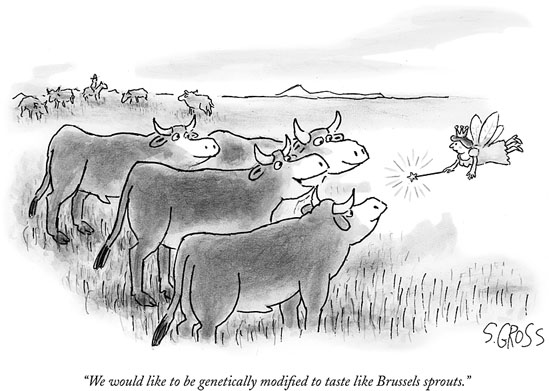
Taste experiences also vary widely across individuals. About 50 percent of people report a mildly bitter taste in caffeine, saccharine, certain green vegetables, and other substances, whereas roughly 25 percent report no bitter taste. Members of the first group are called tasters and members of the second group are called nontasters. The remaining 25 percent of people are supertasters, who report that such substances, especially dark green vegetables, are extremely bitter, to the point of being inedible (Bartoshuk, 2000). Children start out as tasters or supertasters, which could help explain their early tendency toward fussiness in food preference. However, some children grow up to become nontasters. Because supertasters tend to avoid fruits and vegetables that contain tastes they experience as extremely bitter, they may be at increased health risk for diseases such as colon cancer. On the other hand, because they also tend to avoid fatty, creamy foods, they tend to be thinner and may have decreased risk of cardiovascular disease (Bartoshuk, 2000). Genetic factors contribute to individual differences in taste perception (Kim et al., 2003), but much remains to be learned about the specific genes that are involved (Hayes et al., 2008; Reed, 2008).
Our experience of smell, or olfaction, is associated with odorant molecules binding to sites on specialized olfactory receptors, which converge at the glomerulus within the olfactory bulb. The olfactory bulb in turn sends signals to parts of the brain that control drives, emotions, and memories, which helps to explain why smells can have immediate and powerful effects on us.
Smell is also involved in social behaviour, as illustrated by pheromones, which are related to reproductive behaviour and sexual responses in several species.
Sensations of taste depend on taste buds, which are distributed across the tongue, roof of the mouth, and upper throat, and on taste receptors that correspond to the five primary taste sensations of salt, sour, bitter, sweet, and umami.
Taste experiences vary widely across individuals and, like olfactory experiences, depend in part on cognitive influences.